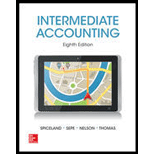
INTERMEDIATE ACCOUNTING
8th Edition
ISBN: 9780078025839
Author: J. David Spiceland
Publisher: McGraw-Hill Education
expand_more
expand_more
format_list_bulleted
Concept explainers
Question
Chapter 19, Problem 19.9Q
To determine
Earnings per share (EPS): The amount of earnings made available to each common share is referred to as earnings per share.
Use the following formula to determine EPS:
To distinguish: Basic EPS from diluted EPS
Expert Solution & Answer
Trending nowThis is a popular solution!

Students have asked these similar questions
Can you show me the correct approach to solve this financial accounting problem using suitable standards?
Solve this question and accounting
What is the inventory turnover ratio if cost of goods sold is $90,000 and average inventory is $15,000?A. 3B. 6C. 9D. 12
Chapter 19 Solutions
INTERMEDIATE ACCOUNTING
Ch. 19 - Prob. 19.1QCh. 19 - Prob. 19.2QCh. 19 - The Tax Code differentiates between qualified...Ch. 19 - Stock option (and other share-based) plans often...Ch. 19 - What is a simple capital structure? How is EPS...Ch. 19 - Prob. 19.6QCh. 19 - Blake Distributors had 100,000 common shares...Ch. 19 - Why are preferred dividends deducted from net...Ch. 19 - Prob. 19.9QCh. 19 - The treasury stock method is used to incorporate...
Ch. 19 - The potentially dilutive effect of convertible...Ch. 19 - How is the potentially dilutive effect of...Ch. 19 - Prob. 19.13QCh. 19 - If stock options and restricted stock are...Ch. 19 - Wiseman Electronics has an agreement with certain...Ch. 19 - Prob. 19.16QCh. 19 - When the income statement includes discontinued...Ch. 19 - Prob. 19.18QCh. 19 - Prob. 19.19QCh. 19 - (Based on Appendix B) LTV Corporation grants SARs...Ch. 19 - Prob. 19.1BECh. 19 - Prob. 19.2BECh. 19 - Prob. 19.3BECh. 19 - Prob. 19.4BECh. 19 - Prob. 19.5BECh. 19 - Prob. 19.6BECh. 19 - Prob. 19.7BECh. 19 - Prob. 19.8BECh. 19 - Prob. 19.9BECh. 19 - Prob. 19.10BECh. 19 - Prob. 19.11BECh. 19 - Prob. 19.12BECh. 19 - Prob. 19.13BECh. 19 - Prob. 19.14BECh. 19 - Prob. 19.15BECh. 19 - E 19–1
Restricted stock award plan
LO19–1
Allied...Ch. 19 - E 19–2
Restricted stock units
LO19–1
On January 1,...Ch. 19 - Prob. 19.3ECh. 19 - Prob. 19.4ECh. 19 - Prob. 19.5ECh. 19 - Prob. 19.6ECh. 19 - Prob. 19.7ECh. 19 - Prob. 19.8ECh. 19 - Prob. 19.9ECh. 19 - Prob. 19.10ECh. 19 - Prob. 19.11ECh. 19 - Prob. 19.12ECh. 19 - Prob. 19.13ECh. 19 - Prob. 19.14ECh. 19 - Prob. 19.15ECh. 19 - Prob. 19.16ECh. 19 - Prob. 19.17ECh. 19 - Prob. 19.18ECh. 19 - Prob. 19.19ECh. 19 - Prob. 19.20ECh. 19 - Prob. 19.21ECh. 19 - Prob. 19.22ECh. 19 - Prob. 19.23ECh. 19 - EPS; concepts; terminology LO195 through LO1913...Ch. 19 - FASB codification research LO192 The FASB...Ch. 19 - Prob. 19.26ECh. 19 - Prob. 19.27ECh. 19 - Prob. 19.28ECh. 19 - Prob. 19.29ECh. 19 - Prob. 1CPACh. 19 - Prob. 2CPACh. 19 - Prob. 3CPACh. 19 - Prob. 4CPACh. 19 - Prob. 5CPACh. 19 - Prob. 6CPACh. 19 - Prob. 7CPACh. 19 - Prob. 8CPACh. 19 - Prob. 9CPACh. 19 - Prob. 1CMACh. 19 - Prob. 2CMACh. 19 - Prob. 19.1PCh. 19 - Prob. 19.2PCh. 19 - Prob. 19.3PCh. 19 - Prob. 19.4PCh. 19 - Prob. 19.5PCh. 19 - Prob. 19.6PCh. 19 - Prob. 19.7PCh. 19 - Prob. 19.8PCh. 19 - Prob. 19.9PCh. 19 - Prob. 19.10PCh. 19 - Prob. 19.11PCh. 19 - Prob. 19.12PCh. 19 - Prob. 19.13PCh. 19 - Prob. 19.14PCh. 19 - Prob. 19.15PCh. 19 - Prob. 19.16PCh. 19 - Prob. 19.17PCh. 19 - Prob. 19.18PCh. 19 - Prob. 19.19PCh. 19 - Prob. 19.1BYPCh. 19 - Prob. 19.2BYPCh. 19 - Prob. 19.3BYPCh. 19 - Prob. 19.5BYPCh. 19 - Prob. 19.6BYPCh. 19 - Prob. 19.7BYPCh. 19 - Prob. 19.8BYPCh. 19 - Prob. 19.9BYPCh. 19 - Prob. 19.10BYPCh. 19 - Prob. 19.11BYPCh. 19 - Prob. 19.12BYPCh. 19 - Communication Case 1911 Dilution LO199 I thought...Ch. 19 - Prob. 19.14BYPCh. 19 - Prob. 19.15BYPCh. 19 - Prob. 19.16BYPCh. 19 - Prob. 19.18BYPCh. 19 - Prob. 19.19BYPCh. 19 - Prob. 19.1AFKC
Knowledge Booster
Learn more about
Need a deep-dive on the concept behind this application? Look no further. Learn more about this topic, accounting and related others by exploring similar questions and additional content below.Similar questions
- Can you solve this general accounting question with accurate accounting calculations?arrow_forwardThe gross profit margin is 40%, and sales are $50,000. What is the cost of goods sold?A. $20,000B. $30,000C. $40,000D. $50,000arrow_forwardAt the end of the year, the company has Assets of $180,000 and Liabilities of $140,000. At the beginning of the year, the company had Owners' Equity of $60,000. How much did Owners' Equity change by the end of the year? Did Owners' Equity increase or decrease?arrow_forward
arrow_back_ios
SEE MORE QUESTIONS
arrow_forward_ios
Recommended textbooks for you
